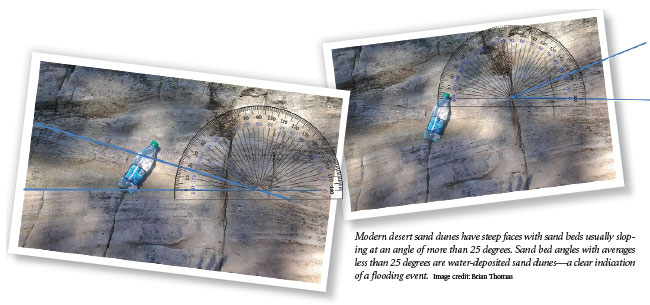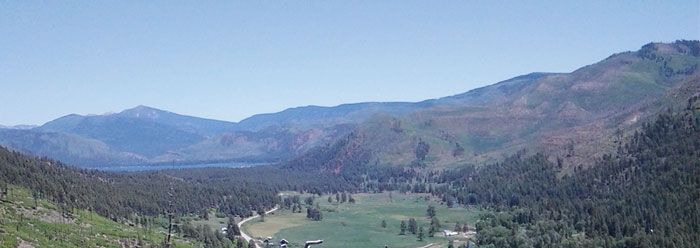Science Writer Brian Thomas recently hiked in Colorado and came across some beautiful examples of cross-bedded sandstone. Why did he get so excited?
While hiking with a youth group in Colorado recently, I came across some beautiful examples of cross-bedded sandstone. They are called cross-beds because the sandstone layers appear to “cut” at an angle to the horizontal bedding. In some areas, the sandstone patterns looked like a giant letter Z. The image shown below is my cell phone snapshot. I shared my excitement with the kids over the significance of what must have seemed to them like just another tan-colored rock. Why are these cross-beds so important?
Their significance has to do with Noah’s Flood. Flood geologists can interpret rock layers like this one in terms of a worldwide watery destruction. The Flood powerfully explains why continents are covered with such thick, catastrophically water-deposited, fossil-bearing, sedimentary rock layers.

In contrast, secular geologists exclude the Flood from their thinking. They view the same layers through the perspective of long ages of regular Earth processes proceeding at familiar rates and scales. Some geologists object to the very idea of a historical Noah’s Flood since they think certain cross-beds represent ancient desert sand dunes—wholly deposited by wind. But water-deposited rocks occur both above and below cross-bedded sandstones. How could a desert exist amid Flood layers? That’s an important question, for if the Flood didn’t happen, then the many scriptural references to Noah can’t be trusted.
How does anyone know for sure that sandstone cross-beds came from ancient deserts? It turns out there’s a relatively easy way to discern whether or not a sand dune was deposited by water or wind. All you need is a protractor to measure the sandstone cross-bed angles.
Since I didn’t have my protractor with me on the trail, I took pictures so I could measure the angles later. Because that whole area is covered in widespread Flood layers, and since the sandstone looked like other Flood sandstones I had seen—like the Glorieta Sandstone in New Mexico—I strongly suspected that the cross-bed angles would match those of other Flood deposits.
Dr. Steve Austin summarized this area of research in his geology text Grand Canyon: Monument to Catastrophe. He cited the work of secular geologists who first noted the similarities between offshore sand dunes caused by storm surges and Grand Canyon deposits. He wrote that modern desert sand dunes can have steep faces, and their “sand beds usually slope at an angle of more than 25°.”1 So, if the angles average less than 25 degrees, you’re looking at water-deposited sand dunes.
After examining the cross-bed angles in the Colorado rocks, my hunch was confirmed. Some were almost 25 degrees and others were less than that, clearly signifying watery deposition. It turns out that secularists agree this particular sandstone was indeed water-deposited, but whenever they insist on desert dune sandstone, one need only ask if they put it to the protractor test. The Colorado sandstone that I saw—which came from a single ancient mega-surge—joins scores of other sandstone deposits from sediment-laden watery surges that unloaded their sediments across Earth’s continents.2 Truly, “the world that then existed perished, being flooded with water.”3
References
- Austin, S. A. 1994. Grand Canyon: Monument to Catastrophe. Santee, CA: Institute for Creation Research, 32.
- The Dakota Sandstone’s cross-beds indicate fast-flowing water extending from Colorado across the northern Great Plains.
- 2 Peter 3:6.
Image credit: Brian Thomas
* Mr. Thomas is Science Writer at the Institute for Creation Research.














